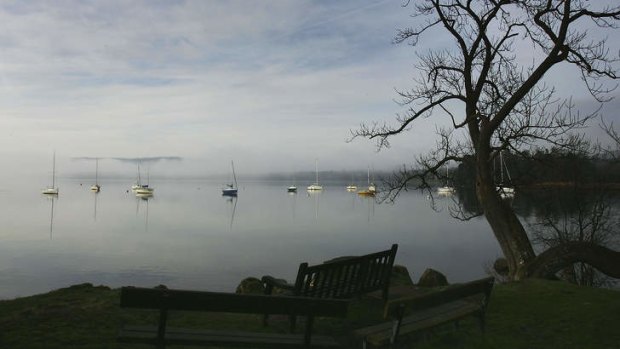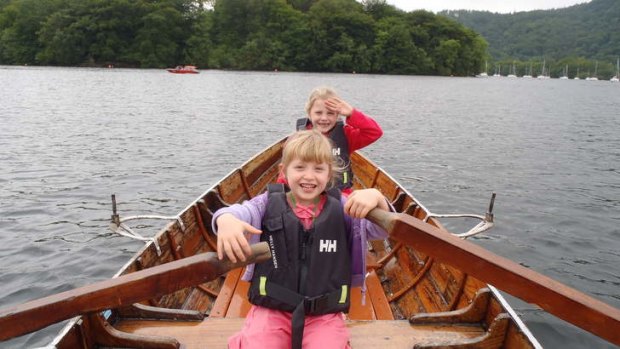This was published 9 years ago
Lake District England: Poets and puddle ducks

Idyllic: Lake Windermere.Credit: Getty Images
It's hard not to wax lyrical in the Lake District, writes Debbie Neilson-Hunter.
It's July in England and summer temperatures have soared to uncomfortable heights; the heatwave is making headlines - barbecue meat sales are up and it's cheek-by-jowl at the coastal beaches as the population searches for relief.
We've pointed our compass north to the scenic Lake District, famous for its abundant rainfall and cool, clean mountain air. The shops in the quaint lakeside villages of Bowness, Windermere and Ambleside are promoting fleeces, down jackets and thermals designed to keep the region's procession of avid country ramblers warm and dry amid average 15-degree temperatures, but we're forced to fish in our bags for the few hats, shorts and tees we'd ambitiously packed "just in case".

Oar-some fun on the lake.Credit: Debbie Neilson-Hunter
Bathed in unusually warm sunshine, the meadows flourish with buttercups and daisies. Alongside hedged lanes that coil around the landscape like lacework, foxgloves add a splash of lipstick pink and pastures are littered with freshly cut grass. The air is perfumed with a mix of floral and earthy scents. And sheep droppings. Yes kids, it's classic Shaun the Sheep country here!
This must be where the phrase "stop and smell the roses" originated. As we explore, I find myself admiring the smallest details: the different shades of lichen creeping over the centuries-old dry stone walls used to control sheep grazing; the way the wind plays with the fluffy tips of the wild cotton grass; a cloud's shadow on the hillside; the reflection of the peaks; and the ripples disturbing the satin surface of Lake Windermere, the most popular of the region's 18 giant lakes.
Such is the scenery and surroundings, it's no surprise that some of the greatest poets of the Victorian age, such as William Wordsworth and John Ruskin, and British authors including Beatrix Potter and Arthur Ransome found inspiration for some of their most celebrated works as they lived and holidayed here.
Attracting about 14.8 million visitors a year, the wildly contrasting and thinly populated north-east corner of Cumbrian England spans more than 2200 square kilometres from Kendal and Cockermouth, as far east as the M6 into Yorkshire and west to the beaches of Ravenglass and Whitehaven. It encompasses the largest of Britain's 15 major national parks, established in 1951.
With just a week to see it all we decided the best way for our little group - whose ages span from five to 70 - to cover the most terrain is via one of the region's guided bus tours. I'm not always a fan of these whistlestop tours but Lakes Supertours proves a wise choice as our drivers skilfully navigate the hairpin bends, narrow roads and steep inclines over the highest passes like Kirkstone and Wrynose - much more skilfully than a first-time visitor ever could.
And despite the lack of airconditioning in our mini-van we find plenty of distraction out of the window. Our driver's commentary is both witty and informative.
Our first Coach & Boat tour to Borrowdale takes us via Ullswater - the second largest lake after Windermere and the inspiration for Wordsworth's most famous poem, Daffodils. We lunch at the market town of Keswick before heading into the Borrowdale Valley. It was settled by Vikings about 1200 years ago and their legacy endures in the Lake District. Many of the place names are derived from Norse and describe the geology: "mere" for pool of water; and thwaite for "clearing". We learn "fells" are mountains and "tarns" refer to the region's 120 smaller lakes.
After we're introduced to Derwentwater from an elevated lookout, we casually cruise it, disembarking at Lodore before heading up the Honister Pass and Valley via the tiny hamlet of Seatoller, England's wettest place, where we find locals bravely swimming in the icy waters. There's no rain brewing today.
We cool down with ice-creams and marvel at the 4500-year-old mysterious Castlerigg Stone Circle which looks out towards the majestic Helvellyn range. We drive on to Thirlmere Lake and the village which Wordsworth aptly described as the "loveliest spot that man hath ever found". He lived in Grasmere at Dove Cottage from 1799-1808, first with his sister Dorothy and then his wife and children (often visited by friend Samuel Taylor Coleridge), before moving to nearby Rydal Mount.
Another day and another tour, aptly named the Rocky Mountain High Spectacular, takes us up the steepest road in England via Hardknott Pass and a 2000-year-old Roman Fort to Wastwater, England's deepest lake. Today's bus adventure gets the thumbs up from the kids as we get to ride a miniature steam train and check out the heritage-listed (and apparently haunted) Muncaster Castle overlooking the Esk River.
Of greater interest to our youngsters are the surrounding grounds which feature the Meadow Vole Maze, vast landscaped gardens, an owl sanctuary, Bird of Prey show and a playground with flying fox.
After lunch here, we journey on to Corney Fell to enjoy spectacular views of the west coast out to the Irish Sea. Final stop is Coniston Water, the scene of countless water speed record attempts (and successes) and the main inspiration behind Ransome's 1930s adventure book Swallows and Amazons.
We save the biggest treat for last - a chance to follow in the footsteps of Beatrix Potter, whose beautifully illustrated tales of Peter Rabbit, Jemima Puddle-Duck, Jeremy Fisher and countless other farmyard animals she observed and loved have entertained children, including mine, for generations. First stop is mock-gothic Wray Castle where a 16-year-old Potter once holidayed. We drive on to Hawkeshead, where Wordsworth was schooled, and where we'll find Potter's original drawings and paintings in the Beatrix Potter's Gallery.
Then it's on to her cottage Hill Top near Sawrey. In the 30 years she lived in the Lake District, Potter bought up a great deal of land in a bid to preserve the region's farming heritage. Hill Top was the first home she bought, in 1905, with profits from her first book. It was one of 15 farms she eventually bequeathed to the National Trust when she died in 1943.
We return to Windermere in the afternoon to relive all 23 of her classic tales at the World of Beatrix Potter Attraction, which is the highlight of our last day.
The writer travelled at her own expense.
TRIP NOTES
GETTING THERE
From London the Lake District is about a six-hour drive north. The nearest airport is in Manchester. Emirates, a partner airline of Qantas, flies from Australia to Manchester. See emirates.com
STAYING THERE
Family-friendly Burnside Park, a Hapimag property at Bowness-on-Windermere, offers self-contained cottages close to Lake Windermere and Bowness village. See hapimag.com/en. Also try the Lakeside Hotel & Spa, Swan Hotel & Spa and the Wordsworth Hotel & Spa. See lakesidehotel.co.uk; swanhotel.com; thewordsworthhotel.co.uk
MORE INFORMATION
Sign up for the Traveller Deals newsletter
Get exclusive travel deals delivered straight to your inbox. Sign up now.